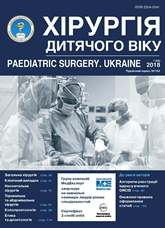Strategy and medical approach to treatment of giant sacrococcygeal teratoblastoma with concomitant teratoma in a newborn child
DOI:
https://doi.org/10.15574/PS.2018.58.61Keywords:
giant sacrococcygeal teratoblastoma, combined treatment, newborn childAbstract
The work presents a clinical case of successful treatment of a giant sacrococcygeal teratoblastoma of external-internal localization and teratoma of internal localization in a newborn child. A preoperative preparation, surgery, and postoperative chemotherapy were administered to ensure a satisfactory result.References
Lev-Chelouche D, Gutman M, Goldman G. (2003). Presacral tumors: a practical classification and treatment of a unique and heterogeneous group of diseases. Surgery. 133(5): 473–478. https://doi.org/10.1067/msy.2003.118; PMid:12773974
Norris HJ, Zirkin HJ, Benson WL. (1976). Immature (malignant) teratoma of the ovary: a clinical and pathologic study of 58 cases. Cancer. 37(5): 2359–2372. https://doi.org/10.1002/1097-0142(197605)37:5<2359::AID-CNCR2820370528>3.0.CO;2-Q
Pappalardo G, Frattaroli FM, Casciani E. (2009). Retrorectal tumors: the choice of surgical approach based on a new classification. Am. Surg. 75(3): 240–248. PMid:19350861
Ritchie AC. (Eds.). (1990). Boyd’s Texbook of Pathology. (9th ed.). Philadelphia and London. 1, 2.
Srivastava A, Jaiswal AK, Jain K. (2010). Sacrococcygeal teratoma. J. Pediatr. Neurosci. 5. 1: 30–31. https://doi.org/10.4103/1817-1745.66682; PMid:21042504 PMCid:PMC2964796
Swamy R, Embleton N, Hale J. (2008). Sacrococcygeal teratoma over two decades: birth prevalence, prenatal diagnosis and clinical outcomes. Prenat. Diagn. 28, 11: 1048–1051. https://doi.org/10.1002/pd.2122; PMid:18973151
Urioste M, Garcia-Andrade MC, Valle L. (2004). Malignant degeneration of presacral teratoma in the Currarino anomaly. Am. J. Med. Genet. A. 128A(3): 299–304. https://doi.org/10.1002/ajmg.a.30028; PMid:15216552
Downloads
Issue
Section
License
The policy of the Journal “PAEDIATRIC SURGERY. UKRAINE” is compatible with the vast majority of funders' of open access and self-archiving policies. The journal provides immediate open access route being convinced that everyone – not only scientists - can benefit from research results, and publishes articles exclusively under open access distribution, with a Creative Commons Attribution-Noncommercial 4.0 international license(СС BY-NC).
Authors transfer the copyright to the Journal “PAEDIATRIC SURGERY.UKRAINE” when the manuscript is accepted for publication. Authors declare that this manuscript has not been published nor is under simultaneous consideration for publication elsewhere. After publication, the articles become freely available on-line to the public.
Readers have the right to use, distribute, and reproduce articles in any medium, provided the articles and the journal are properly cited.
The use of published materials for commercial purposes is strongly prohibited.

